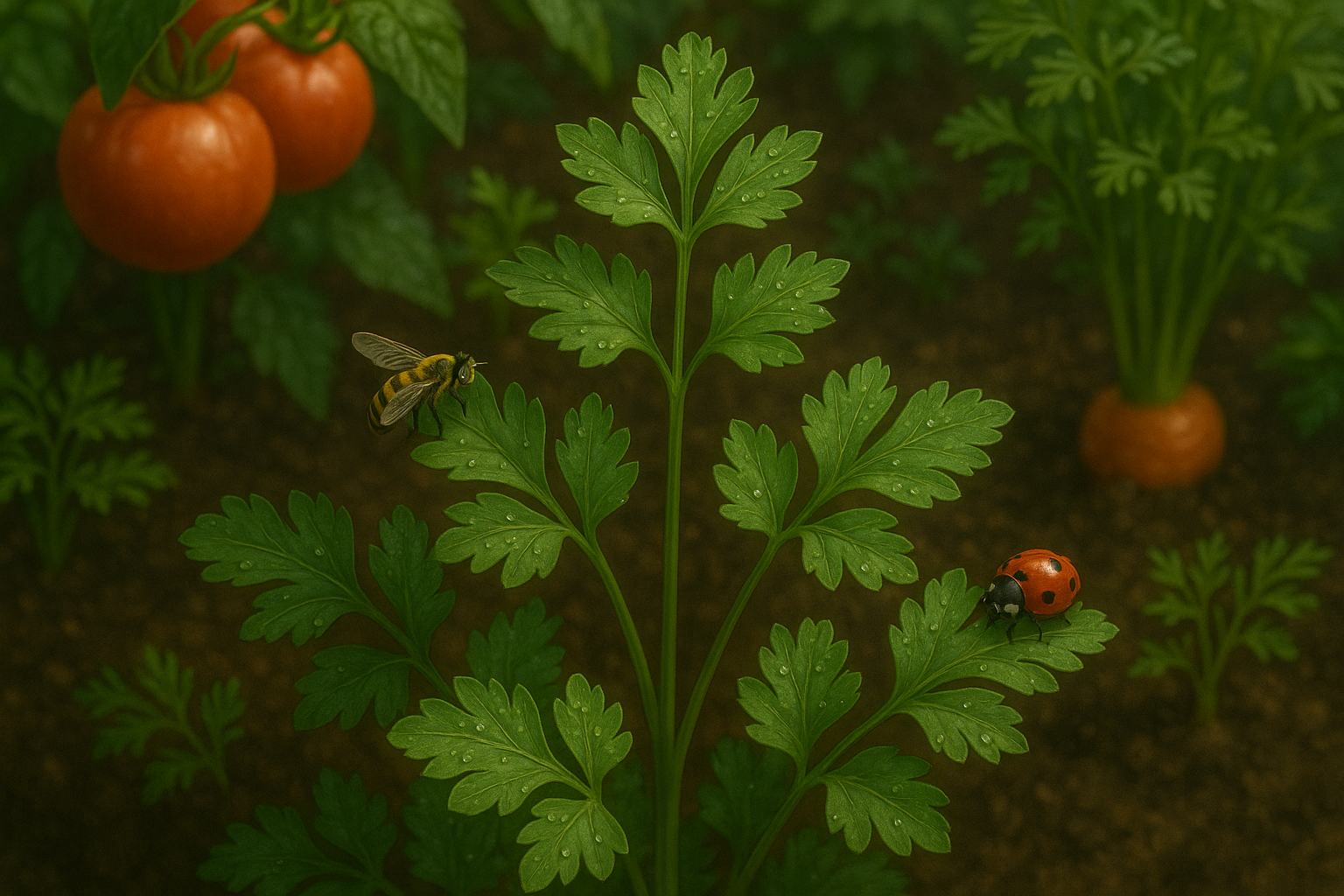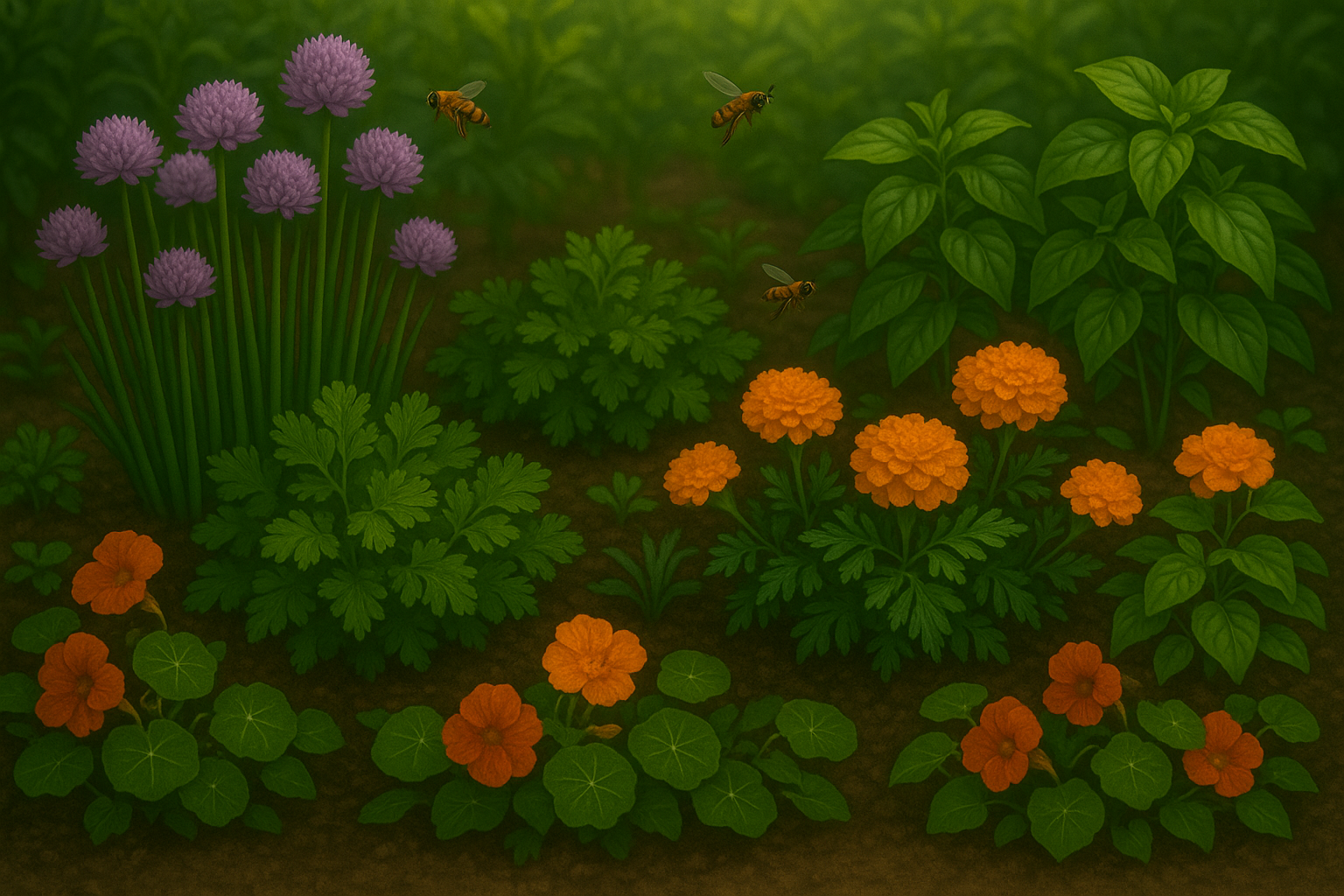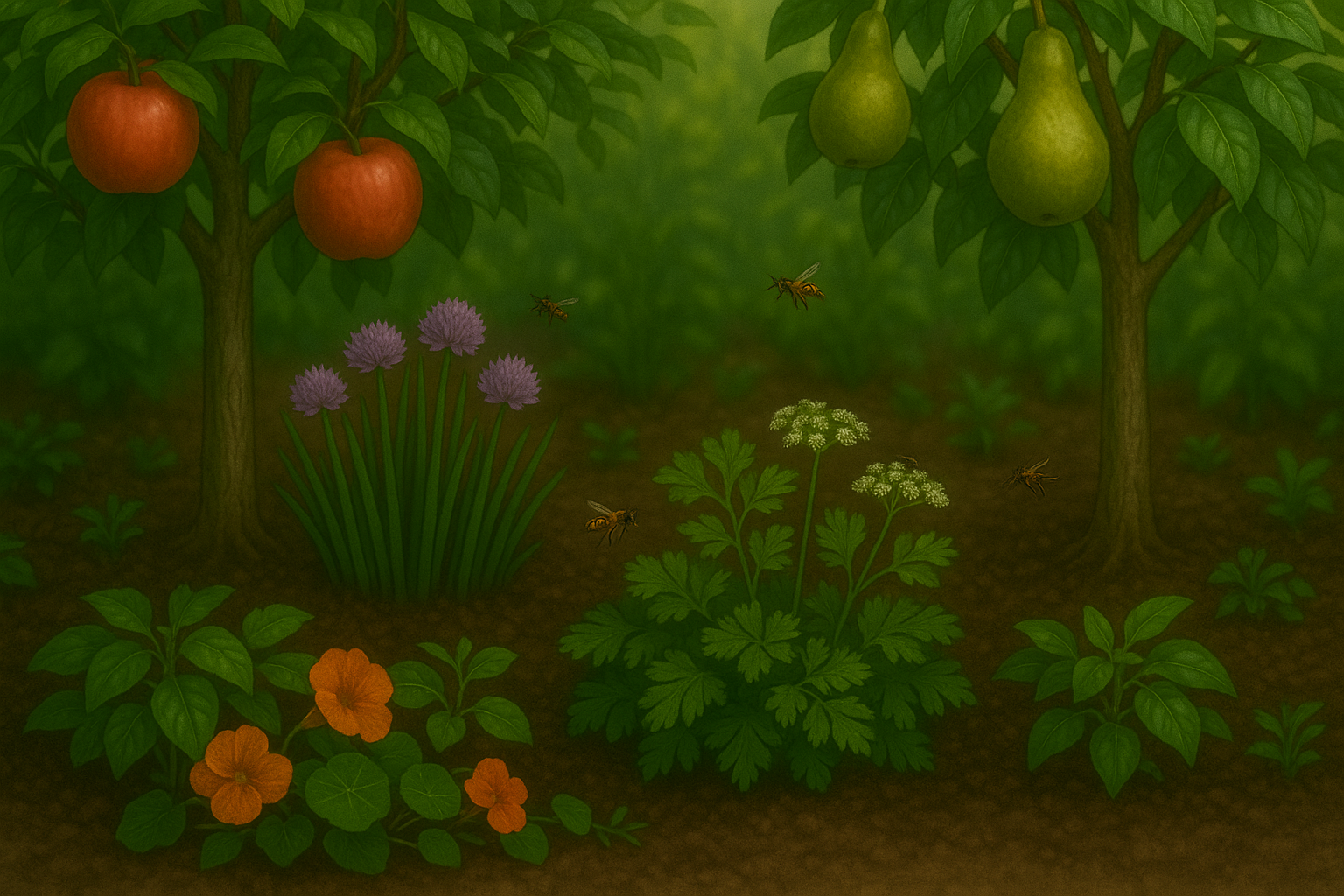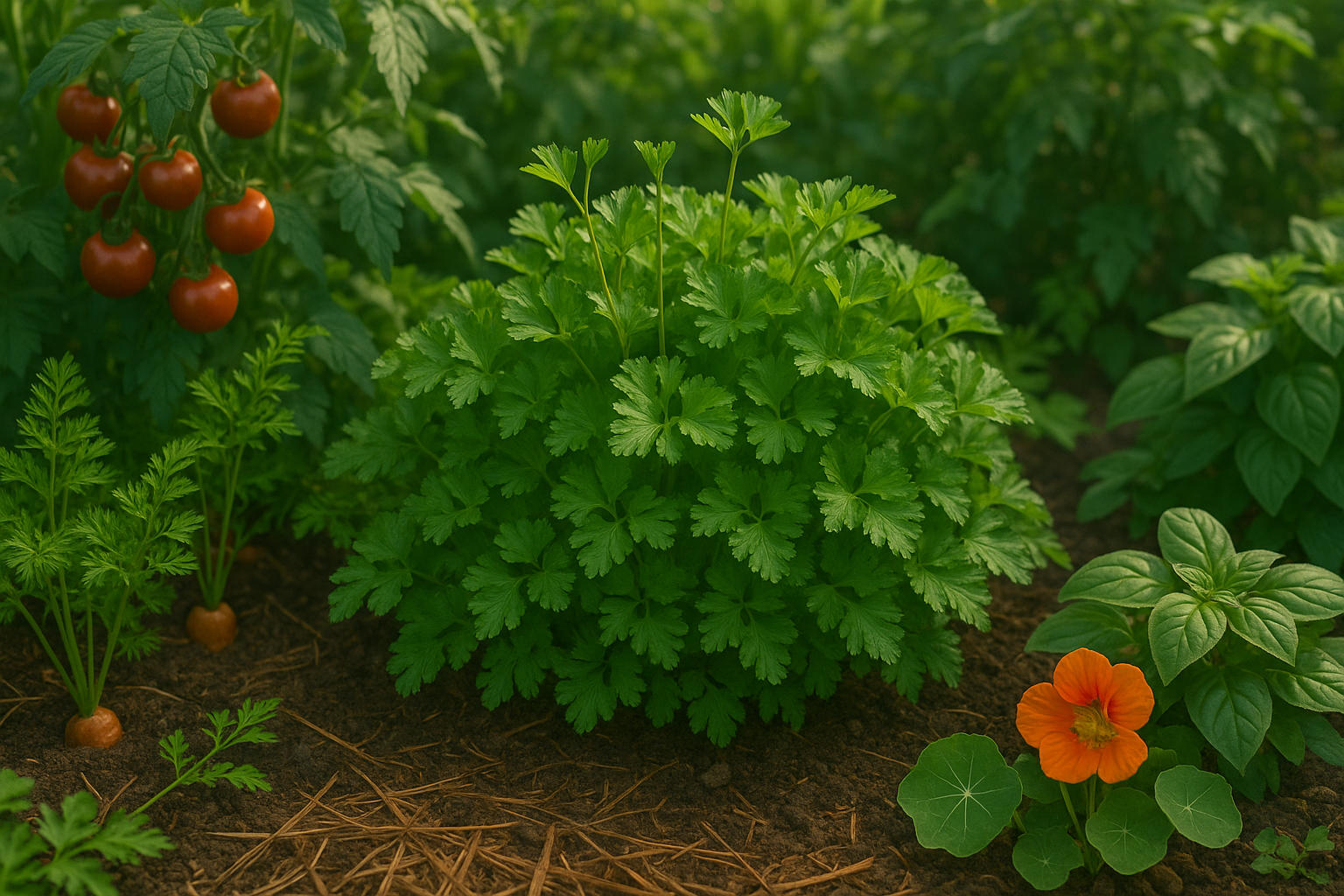Introduction to Companion Planting with Parsley
Parsley companion plants can make a surprising difference in your garden’s success, especially if you’re hoping for lush, vibrant herbs all season long. Companion planting is the practice of growing different plants together to take advantage of the ways they naturally help each other—whether it’s deterring pests, improving soil nutrients, or enhancing growth.
Many gardeners swear by these natural alliances, from marigolds protecting tomatoes to basil keeping aphids away from peppers. Parsley fits right into this eco-friendly approach. It’s not only a staple in kitchens, adding bright, fresh flavor to countless dishes, but it’s also a versatile partner in the garden.
When nestled alongside its best neighbors, parsley can grow bushier, develop a richer flavor, and even gain protection from common garden bugs. For example, planting parsley near tomatoes can boost both plants, while pairing it with carrots may help mask the carrot fly’s scent. Even nasturtiums, known for their colorful blooms, can attract helpful pollinators to parsley’s discreet green flowers.
With a little thoughtful planning, companion planting lets your crops work together, reducing work for you and enhancing the overall health of your garden. It’s an easy, natural way to help your parsley—and everything around it—truly thrive.
Benefits of Companion Planting for Parsley

Companion planting offers numerous benefits for parsley, making it a smart strategy for both beginners and seasoned gardeners. By growing parsley alongside compatible plants like tomatoes, asparagus, and roses, you can boost its health and vigor.
For example, parsley’s natural scent helps repel harmful insects such as carrot flies and aphids, reducing the need for chemical pesticides. In return, some neighbors—like tomatoes—can shelter parsley from harsh midday sun and help maintain moisture in the soil, promoting steady growth.
Planting parsley close to carrots can confuse pests that typically target carrot roots, lessening the damage to both crops. Herbs like basil and chives are also excellent companions for parsley, as their different root zones and nutrient needs prevent competition, ensuring both plants thrive.
Beyond pest control, companion planting can even enhance flavor; gardeners often report that tomatoes grown near parsley taste sweeter and more robust. This approach also creates a more diverse and resilient garden ecosystem, attracting beneficial insects like hoverflies and bees, which improves pollination and natural pest management.
With fewer chemicals and healthier soil, parsley and its neighbors grow stronger together, leading to a bountiful, flavorful harvest and a vibrant, thriving garden overall.
Top Vegetable Companions for Parsley
Pairing parsley with the right vegetables can boost your garden’s health and productivity. Tomatoes thrive next to parsley, as its aromatic leaves naturally deter tomato hornworms and other pests, reducing crop damage. For even better results, intersperse parsley in open pockets between tomato plants, but avoid overcrowding and keep both well-watered.
Asparagus also benefits from parsley’s pest-repelling properties; try planting parsley around asparagus beds to discourage harmful beetles. Peppers find a great companion in parsley, too. The herb’s low, bushy growth offers ground cover that retains moisture and suppresses weeds, so consider planting parsley along pepper rows to maximize space.
When combined with beans, parsley can attract beneficial insects like hoverflies that feed on aphids, helping reduce pest populations. Mix parsley between bean plants, but give each enough space for airflow to prevent disease.
Corn is a tall crop, so edge your corn patch with parsley to draw in predatory wasps that help keep corn pests in check. Parsley works wonderfully with peas as well—plant them together so the taller pea vines provide partial shade for parsley during hot weather, preventing it from bolting.
For brassicas like cabbage and cauliflower, parsley acts as a natural deterrent against cabbage worms and can also attract hoverflies, which prey on common brassica pests. Place parsley near these crops, either in alternating rows or as a border, to boost pest resistance naturally.
To make the most of these pairings, remember to maintain moderate spacing, keep soil consistently moist, and rotate plantings each season to avoid depleting soil nutrients. By mixing parsley with these companion veggies, you create a more resilient, space-efficient, and abundant garden while reducing the need for harsh chemicals—a win for both you and your plants.
Best Herb and Flower Companions for Parsley

Parsley thrives when paired with the right herbs and flowers, making it a smart choice for both garden beds and containers. Among the best companions are basil and chives—both share similar sunlight and soil preferences and help create a healthier microenvironment around parsley.
Basil is known to repel harmful insects like aphids, while chives deter pests such as carrot flies and some fungal diseases, offering natural protection to nearby plants. Flowering companions like nasturtiums and marigolds are equally valuable. Nasturtiums act as a trap crop, luring aphids away from parsley and other herbs. Plus, their bright blooms attract pollinators and beneficial insects like hoverflies.
Similarly, marigolds provide a one-two punch by drawing in pollinators while their strong scent deters nematodes and other garden pests from attacking parsley’s tender roots. For the most success, tuck parsley among these companions in a mixed bed or border, weaving it between the bases of chive clumps or near basil’s leafy stems.
Interplant flowers like nasturtiums or marigolds at the edge, where they’ll spill over pathways and create a welcoming habitat for pollinators. Avoid overcrowding; parsley likes good airflow and thrives with at least six inches of space around each plant. Regularly deadhead marigolds and nasturtiums to keep blooms coming, boosting pollinator visits all season.
By mixing these herbs and flowers, you’ll find your parsley stays healthier, suffers fewer pests, and benefits from the bustling activity of bees and helpful insects—making this companion planting strategy a win-win for any home gardener.
Fruit Trees and Other Surprising Parsley Partners

While parsley is often paired with vegetables and flowers, few gardeners realize that fruit trees like apples and pears also make excellent companions. Planting parsley beneath or around these trees can actually enhance an orchard’s health and productivity.
Parsley’s tiny flowers attract hoverflies and parasitic wasps, which are natural predators of common fruit tree pests such as aphids and caterpillars. This natural pest control reduces the need for chemical sprays and supports a thriving, resilient orchard ecosystem.
Parsley also improves soil health by drawing nutrients up from deep in the soil with its taproot, making them more available to shallow-rooted fruit trees nearby.
When planting parsley in an orchard, give each plant at least 8 to 10 inches of space to avoid crowding roots. It’s best to sow or transplant parsley in a ring beneath the drip line of fruit trees—where rain naturally falls from the outer edges of branches—so the herbs benefit from extra water, and the trees gain from parsley’s protective effects.
Rotate plantings each year to discourage disease buildup and maximize the benefits for both parsley and your trees. Even a modest patch of parsley near your fruit trees can foster biodiversity and contribute to a healthier, more productive orchard.
Plants to Avoid Planting Near Parsley
When planning your garden, it’s important to know which plants don’t play well with parsley. Mint is a top plant to avoid nearby; both are robust growers and will fiercely compete for water and nutrients, often stunting each other’s growth. Lettuce should also be kept at a distance because it attracts the same pests as parsley—like aphids—making your garden more susceptible to infestations.
Alliums (including onions, garlic, and leeks) are another no-no, as they can inhibit parsley’s growth due to allelopathic chemicals they release into the soil. Carrots and parsley come from the same family and can cross-pollinate, sometimes resulting in weaker plants and a muddled flavor profile for both.
Roses and parsley seem unrelated, but grown together they may actually attract pests like aphids, which particularly love rose bushes and will appreciate a parsley snack nearby. Fennel is another to avoid since it’s notorious for its allelopathic effects, suppressing the growth of most garden plants nearby, including parsley.
Instead, consider pairing parsley with tomatoes or peppers; both benefit from parsley’s pest-repelling qualities and create a healthier, more productive garden environment. By choosing the right plant neighbors, you’ll give your parsley the best shot at thriving.
Tips for Successful Companion Planting with Parsley
When planning your garden layout for companion planting with parsley, start by grouping it near crops that thrive alongside it. Tomatoes, carrots, asparagus, and roses are excellent partners, while it’s best to keep parsley away from lettuce and mint to avoid competition or stunted growth.
Prepare the soil by mixing in organic compost and ensuring good drainage, as parsley prefers rich, moist conditions but not standing water. For watering, aim for even moisture—check the soil regularly and water deeply rather than frequently to help roots grow strong without rotting.
Mulching around parsley and its companions will help retain moisture and suppress weeds. Throughout the season, stay on top of weeding, since parsley seedlings can be delicate and easily outcompeted.
Practice crop rotation between seasons to prevent pests and diseases from building up. Avoid planting parsley or its relatives (like carrots or dill) in the same spot year after year.
If you notice yellowing leaves or slow growth, check for crowded roots or signs of fungal disease, and thin out or treat the plants as needed. Address bug issues like aphids quickly—with a blast of water or by introducing natural predators like ladybugs.
With attentive care, your parsley and its garden companions will flourish together.
Conclusion & Quick Reference Chart
Companion planting with parsley is an easy and rewarding way to boost the health and yields of your garden. Growing parsley alongside the right plants helps deter pests, attract pollinators, and make the most of your space. For example, pairing parsley with tomatoes or asparagus can enhance flavor and growth, while planting it near roses helps ward off harmful insects. Avoid placing parsley near lettuce and mint, as they can stunt its growth or compete for nutrients. By experimenting with companion planting, you can create a more resilient garden ecosystem and enjoy more abundant, flavorful harvests with less need for chemicals. Give it a try this season, and observe how your parsley—and your whole garden—thrives.
Quick Reference Chart:
- Plant with: tomatoes, carrots, asparagus, chives, peppers, roses
- Avoid with: lettuce, mint, alliums (onions, garlic), celery
